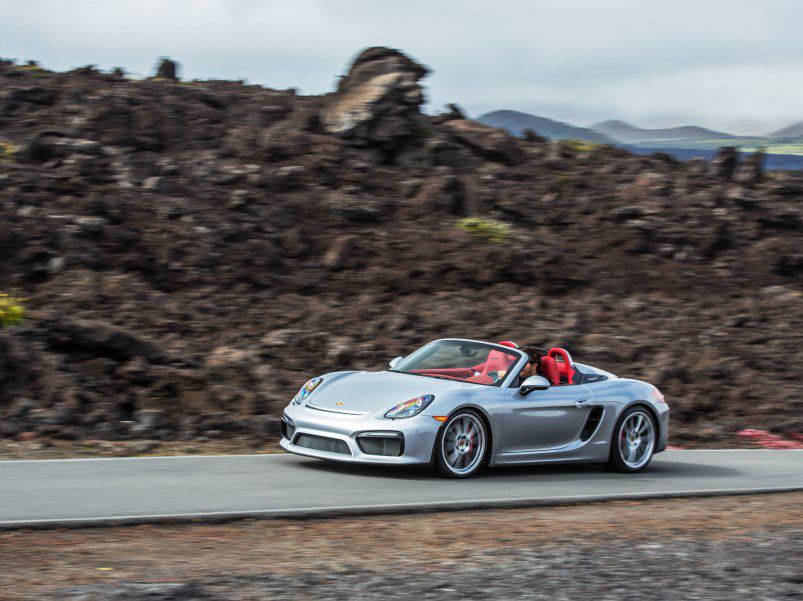Recent Articles
Popular Makes
Body Types
2017 Porsche Boxster Spyder First Drive
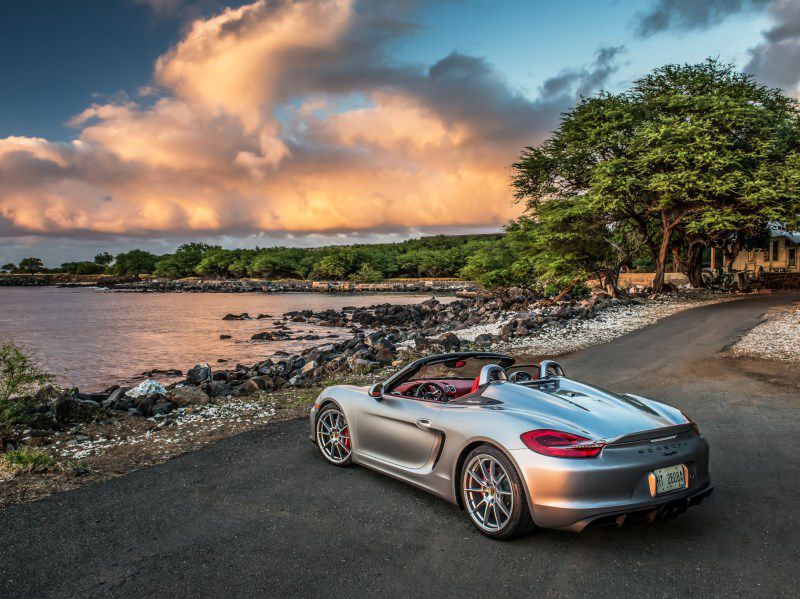
2017 Porsche Boxster Spyder 011
Weight reduction is a succinct but insufficient way to explain why Porsche engineers gave the first-generation Boxster Spyder an incredibly complex roof mechanism, a skimpy bikini that barely kept occupants dry. Derided by many as over-engineered and unpractical, the removable roof did, however, reflect engineering’s prime objective — to build the ultimate open-air sports car for the driving enthusiast. And even those who thumbed their noses at the roof had to raise their thumbs to the car’s fulfillment of that promise.
A little more than five years later, Porsche has introduced the successor to that original Boxster Spyder. The new convertible echoes the classic styling of its predecessor but of course rides on the latest, third-generation Boxster platform and boasts even more power and performance from its mid-mounted flat-6. Better yet, it still retains title as the lightest model in the automaker’s street legal lineup.
Determined to thoroughly explore the new Spyder’s capabilities, and have more than a bit of fun in the process, we grabbed an oversized bottle of SPF 50 suntan lotion and boarded a Boeing 757 jet bound for the Big Island of Hawaii.
Let’s Get the Roof Out of the Way
First, let’s get the roof out of the way.
Literally. In sharp contrast to its predecessor’s toupee (a carbon-fiber and magnesium Erector Set that required an engineering degree), the all-new manually operated soft convertible top requires less than two minutes to stow — no advanced training required, though it does demand you read the owner’s manual to see how it’s done.
First, release an electronic latch centered on the windshield header, which is tasked with keeping tension on the cables; then unclip and stow the soft buttresses. Open the trunk lid — its hinges move it up and rearward — and then fold the top back to collapse into the space between the passengers and the luggage compartment. Close the trunk to complete the process. After a few attempts we were able to complete the process in about 80 seconds. To raise the roof, simply reverse the steps.
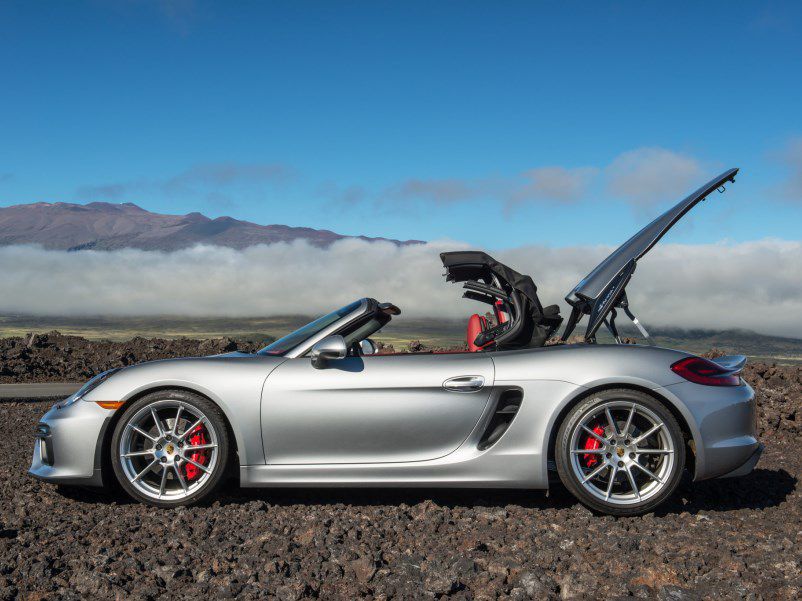
Appreciate the Styling of the Type 981 Spyder
To best appreciate the styling of the Type 981 Spyder, keep the roof stowed away. To differentiate it from standard Boxsters, Porsche designed two prominent streamliners behind the occupant’s heads that pay tribute to the Porsche 718 open-cockpit race car of the 1960s. The front and rear fascias also received cosmetic enhancements, and there is a subtle air outlet at the leading edge of the front trunk — much like that seen on the nose of the GT3.
Twisting the left-mounted key ignites the Spyder’s flat-6 to life. Although impossible to see without the right set of tools, buried mid-ship in the chassis is a naturally aspirated 3.8-liter with a spintastic 7800-rpm redline. On a dyno, the direct-injected powerplant is rated at 375 horsepower and 309 pound-feet of torque, and though those numbers don’t put the Spyder in supercar territory, the two-seater weighs just 2,899 pounds and will make the 0-60 run in 4.3 seconds, says Porsche, which is notorious for conservative estimates of their cars’ performance.

Manual Gearbox
Dropping into the open cockpit reveals even more goodness — three pedals on the floor and a transmission shift lever jutting from the center console. Unlike most everyone else in the industry, Porsche still offers vehicles available only with manual gearboxes (needless to say, the clutch is effortless to use, perfectly balanced with predictable take-up), welcomed by enthusiasts who still want to feel connected to the machine, even at the expense of ultimate performance.
Anyone who has visited the Hawaiian Islands will tell you they aren’t especially welcoming to driving enthusiasts. Speed limits are typically lower than on the Mainland, the roads are not particularly smooth, and the locals usually drive at leisure velocities that reflect the laid-back atmosphere of life in paradise. The biggest island in the Hawaiian chain, the Big Island, is laced with incredibly scenic roads, though with speeds limited to just 60 mph we obviously could not test the Boxster Spyder’s maximum stated velocity — three times the posted legal limits.

Occupant Accommodation
Nevertheless, Porsche plotted a solid drive route that circulated around the island in the morning and bisected it on our afternoon return. During that day, we found curves that would shame Mulholland Dr. itself, and enticing straights that felt more open than those on the Autobahn.
Passengers sit deep inside the Boxster Spyder, with the doors at shoulder level. Both occupants are held snugly in place by standard Sport Seats Plus. The driver is perched behind a slightly smaller diameter sport steering wheel (360 mm vs. 370 mm in other Boxster models) and faces a traditional set of analog gauges with a digital information screen. Outward vision is excellent with the top down, but there are sizeable blind spots when it’s up — yet another reason to keep it stowed except in the rain.
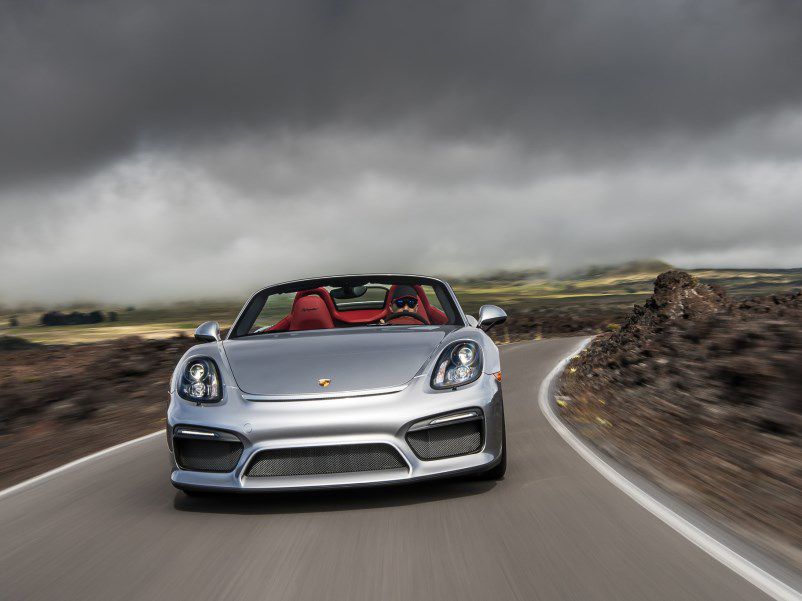
Sportiest Boxster Model
Porsche has tuned the Spyder to be the sportiest Boxster model, aimed at the enthusiast who wants to wring out every ounce of performance from their car. Its standard sport suspension is aggressively firm — riding stiffer than the GTS, but not as hard as the Cayman GT4 — and its ride height is 20mm lower than its siblings. Cornering is flat, body roll unnoticeable.
The two-seater has plenty of grip thanks to standard 20-inch wheels wrapped in performance-rated rubber (235/35-20 front, 265/35-20 rear), and the overall balance is very neutral as befits a car with the engine placed between the axles. While there isn’t enough power to break the rear wheels free in a straight line (the mid-engine configuration puts plenty of weight over the contact patch) the tail may easily be provoked to whip around mid-corner with the stab of the throttle. Hoots of fun, without question.
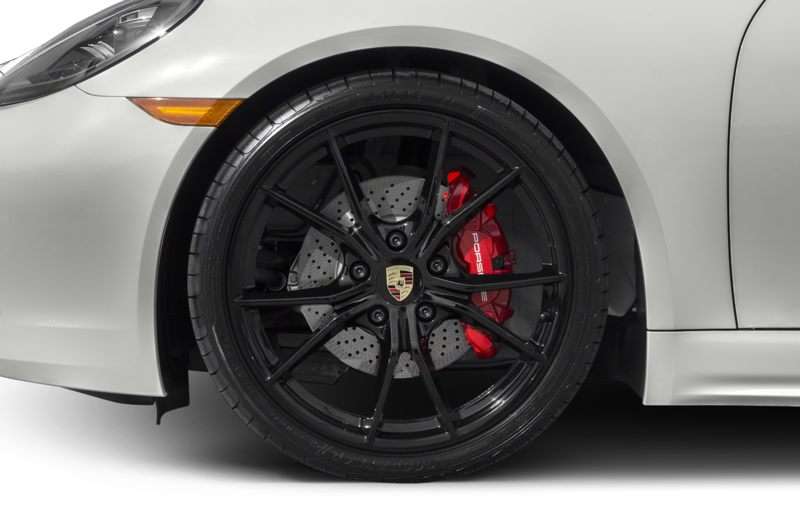
Standard-Less Features
The brakes and their big red calipers have been borrowed directly from the Carrera S. The Spyder is a couple hundred pounds lighter, so they are tasked with doing less work and make stops are short and straight, with easily modulated yet firm pedal feel. Jab the brakes at speed, and they work almost too well, as the ABS quickly gets involved.
As with the previous Spyder, neither an audio system nor air conditioning come standard — weight reduction, remember? Nonetheless, our test vehicle was fitted with both, and we would probably outfit our own Spyder with those creature comforts too, as they add minimal weight but keep passengers (who aren’t enjoying the driving experience) happy.
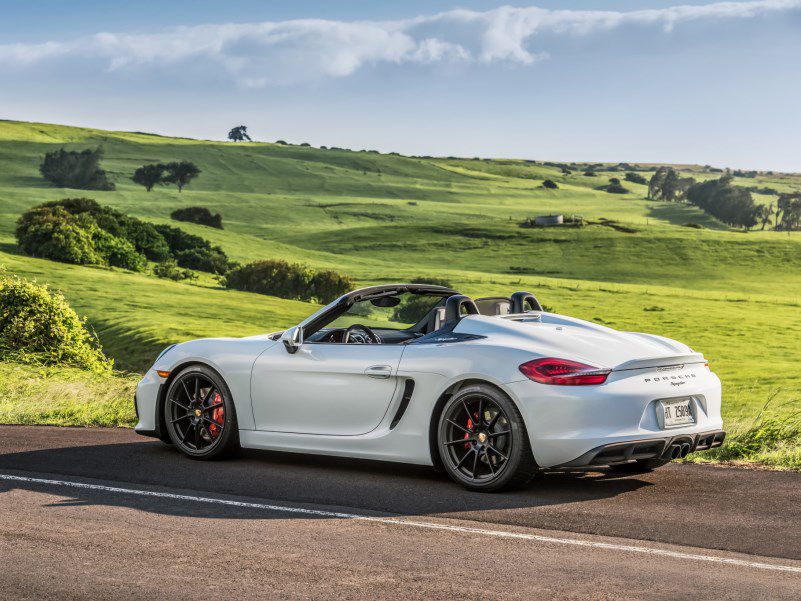
Refined Powerplant
Hands-down our favorite part of the new Boxster Spyder has to be its engine. The 3.8-liter is a refined powerplant that begs to be driven hard, really comes to life once the tachometer passes 3500 rpm, and gives up none of its character until the tach needle bounces off the rev limiter. Those who appreciate a well-polished powertrain especially will love the idyllic interaction between second and third gears on a tight road. Even if this 3.8 lacks the low-end punch of the new 3.0-liter twin-turbocharged Carrera engines, the increased displacement (the first-gen Spyder boasted a 3.4L) means more power down low and enough torque so that taller gears can be used around town.
The engine’s intake acoustics mimic a vocal bullfrog, brash and throaty, while the twin center-mounted exhaust pipes bellow out a raucous tune as the engine spools towards fuel cutout — it seems never to fall off. Porsche fits an exhaust note switch, which toggles flaps inside the muffler to silence some of the commotion, but the only difference we heard was that one position is loud and the other is very loud.
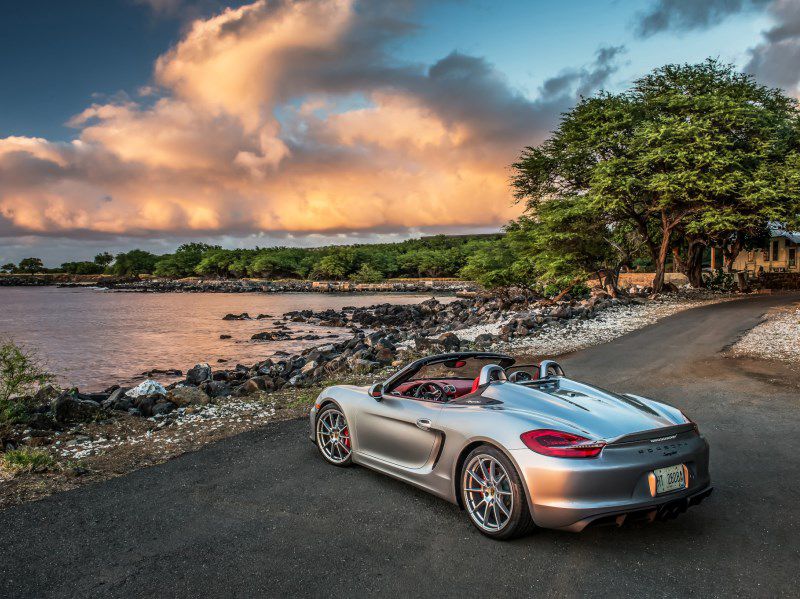
Blissful Driving
After a full day of blissful driving on the Big Island, our biggest concern was directed at the raised roof. Although completely redesigned and much more weather- and windproof than its predecessor, when deployed it allows lots of wind noise to permeate the cabin. Standard and GTS Boxster models are fitted with quieter multi-layer lined roofs, but the Spyder’s is but a single layer with exposed wires and cables on the inside. The sound of wind rushing over the fabric, and around the flying buttresses just aft of the passenger’s ears, becomes tiring. The solution is, of course, to drop the roof and enjoy even more the engine’s song.
We were smitten with the new Boxster Spyder. Its powerful engine, focused performance tuning, and unique cosmetic attributes raise the bar while completely differentiating it from its standard siblings. While the average affluent car buyer would likely be better off with a Boxster S or GTS model, both better daily drivers, die-hard enthusiasts will cherish the Spyder’s eccentricities and embrace the elevated performance — we certainly did during our short time with the car, and the experience, as it is with all great cars, has us lusting for more.
